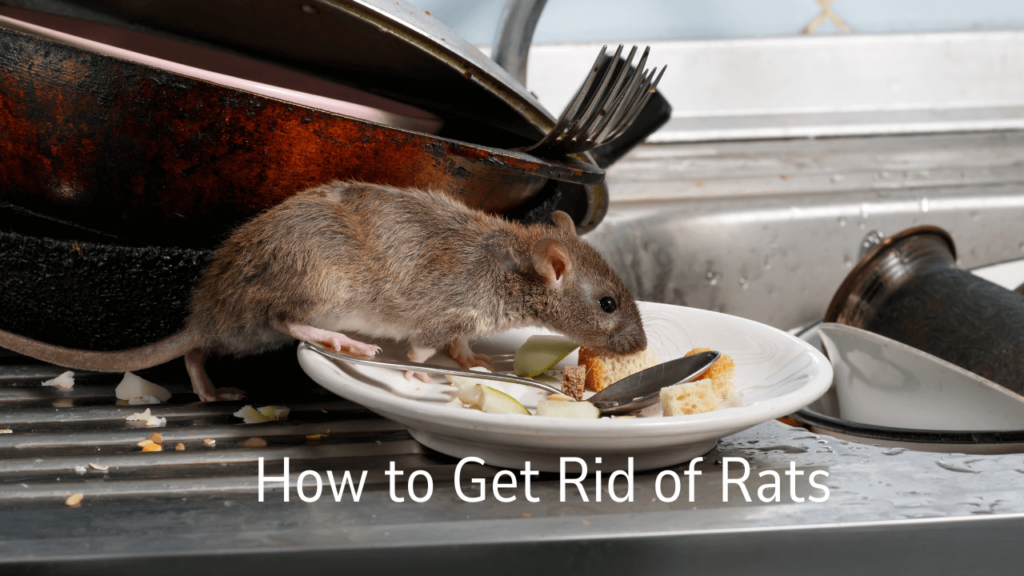Rats are more than just a nuisance—they pose serious health risks, cause significant property damage, and disrupt the peace of your home. These resilient pests can quickly multiply, turning a small issue into a full-blown infestation. Whether you’re dealing with rats in an urban apartment, a rural property, or a commercial space, understanding how to eliminate and prevent them is essential.
In this guide, we’ll walk you through practical steps to identify a rat problem, implement effective control methods, and create a long-term strategy to keep your space rat-free. From prevention tips to humane solutions, this comprehensive resource equips you with everything you need to tackle rat infestations head-on.
Understanding the Rat Problem
Before addressing a rat infestation, it’s important to understand the species, signs of their presence, and their behavior. This knowledge helps in choosing effective control methods.
Identifying Rat Species
- Norway Rats (Rattus norvegicus): Large, stocky, with gray-brown fur. Prefer burrowing in basements, sewers, or ground areas. Excellent swimmers.
- Roof Rats (Rattus rattus): Smaller, sleek, with black fur and pointed noses. Prefer high nesting areas like attics or roofs. Skilled climbers.
Signs of Infestation
- Droppings: Pellet-shaped; larger for Norway rats, smaller and pointed for roof rats.
- Gnaw Marks: Chewed wires, wood, or food packaging.
- Noises: Scratching or scurrying at night from walls or ceilings.
- Odor: Musty smell from urine and droppings.
- Sightings: Daytime rat sightings indicate severe infestation.
Understanding Rat Behavior
- Feeding: Rats eat almost anything and are attracted to waste, pet food, and human food.
- Reproduction: Rapid breeders; a single pair can lead to hundreds within a year.
- Nesting: Prefer hidden, warm spaces like attics, basements, or behind walls.
- Territorial: Established rats deter others unless resources are scarce.
- Activity: Mostly nocturnal but may appear during the day if disturbed or food is limited.
Understanding these aspects helps in identifying problems early and creating effective strategies for control and prevention.
Prevention Strategies
Preventing a rat infestation is more cost-effective than dealing with one. Focus on sealing entry points, managing food and waste, and removing nesting sites to make your property less inviting.
1. Sealing Entry Points
- Inspect for Gaps: Check walls, foundations, windows, doors, pipes, and roof vents for holes or cracks.
- Seal Gaps: Use caulk, steel wool, and wire mesh to block potential entry points effectively.
2. Food and Waste Management
- Secure Waste: Use tightly sealed, rat-proof garbage bins and dispose of food scraps properly.
- Store Food Properly: Keep food and pet supplies in airtight, rodent-proof containers. Clean crumbs and spills regularly.
3. Eliminating Nesting Sites
- Clear Clutter: Remove piles of leaves, wood, or debris. Trim overhanging branches and dense vegetation near the home.
- Manage Woodpiles: Store firewood 18 inches above ground and away from the house. Cover or dispose of garden waste promptly.
These steps minimize attractants and create a hostile environment for rats, reducing the risk of infestation.
DIY Rat Control Methods
If you already have rats on your property, taking immediate action is critical to prevent the infestation from worsening. While professional pest control is effective, many homeowners prefer to try do-it-yourself (DIY) methods first. In this section, we will explore the most common DIY rat control methods, including using traps, repellents, and poisons, and discuss the pros and cons of each.
Traps: Types and Best Practices
Traps are one of the most popular and effective ways to catch and eliminate rats. They are cost-effective, easy to set up, and available in various designs to suit different needs. Below are the most commonly used types of traps and tips for using them effectively.
Snap Traps
Snap traps are the traditional and most widely used type of rat trap. They are designed to kill rats instantly with a spring-loaded bar.
- Advantages: Quick and humane if set properly, reusable, and inexpensive.
- Disadvantages: Requires careful placement to avoid harming pets or children.
How to Use Snap Traps Effectively:
- Place traps along walls or in areas where you’ve noticed rat activity, as rats tend to follow the same paths.
- Use bait like peanut butter, cheese, or fruit to attract the rats.
- Check traps regularly and dispose of any caught rats promptly.
Glue Traps
Glue traps are sticky boards that trap rats when they walk across them. These are best used for smaller rodents and light infestations.
- Advantages: Easy to use, no need for bait, and disposable.
- Disadvantages: Considered less humane, as the rat does not die instantly. Ineffective for larger rats or in dusty areas.
How to Use Glue Traps Effectively:
- Place traps in high-traffic areas for rats, such as near entry points or along walls.
- Avoid placing them in dusty or wet areas, as this can reduce the adhesive’s effectiveness.
Live Traps
Live traps are humane traps designed to catch rats without killing them. These traps allow you to release the rats far from your property.
- Advantages: Non-lethal, reusable, and safe for use around children and pets.
- Disadvantages: Requires you to handle and relocate live rats, which can be stressful and pose health risks.
How to Use Live Traps Effectively:
- Bait the trap with attractive food, such as peanut butter or dried fruit.
- Release the trapped rats at least a mile away from your property to prevent them from returning.
Repellents: Natural and Commercial Options
Repellents work by deterring rats from entering or staying in an area. These can be chemical, ultrasonic, or natural remedies. While repellents may not eliminate an existing infestation, they are effective for prevention and minor control.
Natural Repellents
Natural repellents are eco-friendly and safer alternatives to chemical options. Rats are sensitive to certain smells and will avoid areas where these are present.
- Peppermint Oil: Soak cotton balls in peppermint oil and place them near entry points or areas of rat activity. The strong smell repels rats, but it must be reapplied regularly.
- Ammonia: Ammonia mimics the scent of predator urine and can deter rats. Place small bowls of ammonia in problem areas, but keep them out of reach of children and pets.
- Chili Powder: Sprinkle chili powder or make a spray solution with water to apply near entry points. The strong smell and irritation discourage rats.
Ultrasonic Repellents
Ultrasonic devices emit high-frequency sounds that are unpleasant to rats but inaudible to humans.
- Advantages: Safe for use around children and pets, easy to install.
- Disadvantages: Limited range and effectiveness, as rats can become accustomed to the sound over time.
How to Use Repellents Effectively:
- Combine repellents with other control methods, such as traps or sealing entry points, for the best results.
- Regularly refresh natural repellents and ensure ultrasonic devices are placed near areas of high rat activity.
Poisons: Risks and Guidelines
Rat poisons, or rodenticides, are a chemical solution for eliminating rats. While they can be effective, they come with significant risks and should be used with caution.
Types of Rat Poisons
- Anticoagulants: These cause internal bleeding in rats, leading to death over a few days. Examples include bromadiolone and warfarin.
- Neurotoxins: These act more quickly, affecting the rat’s nervous system. Examples include bromethalin.
Advantages:
- Highly effective for large infestations.
- Can eliminate multiple rats at once when used with bait stations.
Disadvantages:
- Dangerous to children, pets, and non-target animals if ingested.
- Dead rats may remain hidden, causing odor and hygiene issues.
How to Use Poisons Safely and Effectively:
- Use tamper-resistant bait stations to prevent accidental ingestion by pets or children.
- Place bait stations in areas where rats are active but inaccessible to humans and pets.
- Monitor the area regularly and dispose of any dead rats promptly to avoid secondary poisoning of other animals.
Pros and Cons of DIY Methods
While DIY methods are often the first step in dealing with a rat infestation, they come with their own set of advantages and limitations.
Pros:
- Cost-effective compared to professional pest control.
- Allows you to handle the problem immediately without waiting for professional assistance.
- Wide variety of options to suit different needs and situations.
Cons:
- Requires time, effort, and consistency to see results.
- May not be effective for severe infestations.
- Some methods, like poisons, carry risks to household members and pets.
DIY methods can be effective for managing small to moderate rat infestations, especially when combined with prevention strategies. However, if the problem persists or worsens, it’s often best to seek professional assistance. In the next section, we’ll discuss when and how to call in the experts for rat control.
Get Rid of Rats Without Killing Them
Eliminating rats without harming them is a humane approach that focuses on deterrence and relocation. Here are the main strategies:
1. Use Live Traps
- What It Does: Catches rats without harming them, allowing for relocation.
- How to Use: Bait the trap with food like peanut butter, place it in high-activity areas, and release the rats at least one mile away in a suitable environment.
2. Seal Entry Points
- What It Does: Prevents rats from entering your property.
- How to Use: Inspect your home for gaps and holes, then seal them with materials like steel wool, caulk, or mesh.
3. Employ Natural Deterrents
- What It Does: Repels rats using smells they dislike.
- How to Use: Place peppermint oil-soaked cotton balls, chili powder, or ammonia near entry points or rat-prone areas.
4. Ultrasonic Devices
- What It Does: Emits high-frequency sounds that irritate rats but are inaudible to humans.
- How to Use: Install devices in areas with frequent rat activity.
5. Remove Attractants
- What It Does: Makes your property less appealing to rats.
- How to Use: Store food in airtight containers, clean up crumbs, secure garbage bins, and eliminate standing water sources.
6. Maintain a Clean Environment
- What It Does: Reduces potential nesting sites.
- How to Use: Declutter storage areas, trim vegetation around the home, and store woodpiles off the ground.
7. Encourage Natural Predators
- What It Does: Deters rats by introducing their natural enemies.
- How to Use: Attract owls or snakes by creating a welcoming habitat in your yard, such as installing owl boxes.
These non-lethal methods require patience and consistency but are effective in managing rat problems humanely.
Long-Term Rat Control and Maintenance
Effective rat control isn’t a one-time effort—it requires ongoing vigilance and maintenance to prevent future infestations. Here are the key strategies for long-term success:
1. Continual Monitoring
- Regular Inspections: Conduct routine checks around your property for new gaps, droppings, or other signs of rat activity. Early detection is critical to preventing infestations.
- Monitoring Traps and Baits: Keep an eye on traps or bait stations, replacing or relocating them as needed to maintain effectiveness.
2. Maintaining a Rat-Proof Environment
- Updating Sealing Techniques: Over time, wear and tear can create new entry points. Regularly inspect and reinforce seals around windows, doors, and other potential access points.
- Managing Food and Waste Year-Round: Always store food in airtight containers, secure garbage bins, and promptly clean up spills. Seasonal changes can increase rat activity, so consistent practices are vital.
3. Community Involvement
- Shared Responsibilities: Work with neighbors to address shared spaces, such as alleyways, gardens, or communal trash areas. A collective effort can significantly reduce rat populations.
- Preventing Reinfestation: Encourage community clean-ups, share tips on rat-proofing, and report any infestations early to prevent spreading.
By staying proactive and involving your community, you can maintain a rat-free environment over the long term.
Dealing with Rat Infestations in Specific Areas
Different environments and locations require tailored approaches to rat control. Below are the key strategies for managing infestations based on the setting:
1. Urban vs. Rural Settings
- Urban Challenges: High-density areas make rat control difficult due to shared spaces like alleyways, garbage bins, and public areas. Focus on community efforts and maintaining cleanliness.
- Rural Challenges: Farms and open spaces attract rats due to food sources and shelter in barns, crops, and fields. Regular inspections and securing feed storage are crucial.
2. Rats in Commercial Spaces
- Food Businesses: Strict sanitation practices and sealed food storage are critical to avoid contamination and health violations.
- Warehouses and Storage Areas: Use tamper-proof bait stations and maintain a clutter-free environment to eliminate nesting sites. Regular pest control checks are essential.
3. Dealing with Rats in Outbuildings
- Sheds and Garages: Keep these spaces clean, organized, and free of food sources. Seal any gaps and avoid storing edible items like pet food or seeds.
- Barns: Protect animal feed in metal containers, clear out clutter, and install traps or repellents to control populations.
Tailoring your approach to the specific area ensures effective and lasting control of rat infestations.
Conclusion
Dealing with a rat infestation requires a combination of preventive measures, immediate control methods, and long-term strategies. By sealing entry points, managing food and waste, and employing traps or humane deterrents, you can eliminate existing infestations and prevent future ones. Tailoring your approach to specific environments, whether urban, rural, or commercial, ensures a comprehensive solution.
Long-term success depends on consistent monitoring, maintaining a rat-proof environment, and fostering community cooperation. Whether you choose DIY methods or professional pest control, addressing the issue early and systematically is key to protecting your health, property, and peace of mind.

Hi, I’m Tanvir, the founder and author of Explore Ireland Now. With a deep love for Ireland and its rich culture, history, and landscapes, I created this site to share everything that makes this beautiful country worth exploring. Whether you’re a local looking for hidden gems or a traveler planning your next adventure, I provide insightful guides, tips, and recommendations to help you experience Ireland to the fullest.
From stunning landscapes to vibrant cities and quaint villages, Ireland is full of wonders waiting to be discovered. Through my personal experiences and research, I aim to bring you the most up-to-date information and inspiration for your journey.
Thank you for visiting Explore Ireland Now—I hope my content helps you uncover all that this incredible country has to offer! If you have any questions or need travel advice, feel free to reach out.



